INSPIRATION
My initial interest in devotional images was birthed in my childhood. The first devotional images I encountered were found within some old family bibles that I found on book shelves in various family members homes. I was fascinated by these depictions of divine beings and biblical figures. At school I would go to the library and check out various art books that depicted images created by the old European Renaissance Masters – especially those featuring the works of Da Vinci and Durer. In college, I was once again drawn back to these same images with a greater capacity for understanding after I entered art school and began to receive in-depth training in drawing, painting, and art history.
My first attempt at creating a devotional image did not occur until I received a commission from the President of my seminary – Dr. Louis Charles Harvey. He commissioned me to create a large watercolor illustration of African slaves with wings on their feet flying up and away from the plantation fields and into the vast expanse of the heavens. His inspiration for this image was based upon the old Negro Spiritual, Steal Away to Heaven. I later completed a second image based upon the biblical Annunciation event (the angel Gabriel informs Mary that she has been chosen to conceive Jesus – Luke 1.26-38) for a doctoral class on Christian iconography.
The impetus for the “When We Pray” series was birthed out of my own personal experiences with prayer and meditation. Prayer is an essential component of the spiritual life and its importance is emphasized throughout all spiritual traditions. Although we often make a distinction between prayer and meditation, the two often support and interpenetrate one another. For my purposes, prayer can most easily be defined as communication with the divine. Prayer, like any other form of communication must involve both sending and receiving. Thus it occurs within the context of dialogue and mutuality. In order for this mutuality to be authentic there must be some real capacity for both parties to affect and be affected.
We could also define prayer as the movement or opening of the heart towards the divine. This movement or opening involves a change of focus and orientation that tunes one in to the divine frequency so that one is prepared to engage with the divine in dialogue and mutuality. From this perspective, one simply seeks spirit through the focus of attention and expectation on the divine and communication results as a natural part of the process. The underlying assumption is that our creator wants to be to in communion with the creation in dialogue and mutuality.
SYMBOLISM
My intention was to create an image which depicted: a) my understanding of prayer, and b) visually communicate the mood and feelings which accompanied some of my own experiences with prayer and meditation. I wanted to give birth to all of the sensations I had experienced energetically, emotionally, psychically, and physically. At the outset, there was no plan to create a series of images, there was simply a compelling desire to make visible the invisible, to encapsulate that which is universal within the particularity of a single image. Each daily encounter with spirit provides new experiences and information that can fuel another image, always the same and yet somehow always miraculously different. It is this miraculous quality which spurred me to complete more images over the course a year. It wasn’t until I had begun the fifth image that I decided to complete the series at seven works – thus symbolizing completion.
All of the works contain two constant motifs: 1) the divine presence being symbolized through the use of a hand(s), and 2) each figure is cocooned within a pulsating field of spiritual energy. The presence of these two motifs in each image is a visual representation of the quality of sameness or consistency that accompanies prayer and meditation, yet all the while other aspects of theses same elements can be different or convey slightly different qualities. It is the same, yet at the same time always different. In these works this quality is conveyed by depicting each cocoon differently, the hand (or hands) are depicted in varying positions, and in each image symbols are present but they vary in size, shape, and meaning.
Hands
The symbolism of hands is pregnant with a wide range of possibilities. The divine hand is an image that is encountered across a wide range of religious literature. The Christian bible often makes references to the hand or finger of God resting upon, supporting. protecting, surrounding…various persons and situations. The Exodus narrative is a perfect example of the use of this symbol with great effect (for more information see my blog post from October 2014). In my personal experiences the divine presence expresses its self in a variety of ways that often give me sense of being held, caressed, protected, stroked, supported, guided or whatever else may be appropriate at that particular time. This sense is one which I have experienced consistently within my prayers and meditations.
Divine Energy/Light
The sensation of energy, light, Chi, Holy Spirit, aura, magnetic fields, bioelectricity…is one of the most widely acknowledged examples of the various ways one can encounter spiritual power during prayer and meditation. Although many of these terms describe very distinct forms of experience they all ultimately originate from one common divine source. Each praying figure is surrounded by a divine light which is intentionally biomorphic in form and unclear in origin. One is not sure if the light originates from the praying figure, or one of the symbols which are depicted within the image. I deliberately chose to alternate the tone of the light surrounding each figure by depicting the energies in black (Fig. 1, 3, 5 & 7) or white (Fig. 2, 4 & 6).
I
This is the 1st image in the series. The hands symbolize the presence of the divine supporting, sustaining, protecting, touching, caressing, loving…each of us as we open ourselves to know and be known. In this image the cross represents divine sacrifice and protection, while our connection to the divine is represented through the Tibetan symbol of enlightenment within and above the figure.
II
This 2nd image makes use of a single hand which supports the standing figure. The divinity within is represented by the Reiki symbol of enlightenment emanating from the figures back. The Yantra behind the figure is the Sodasi which represents perfection, totality and the full cycle of creation.
III
This is the 3rd image of the series. The symbol behind the figure is the Islamic Hand of Fatima which is indicative of divine protection, and the Egyptian Eye of Horus which represents enlightenment and supra-natural intuition. The aureole-like 8 point star is indicative of enlightenment, the Bahai faith, and the 8-fold path of the Buddha. The transfer of energies is symbolized by the yin/yang symbols within and below the meditating figure.
This 4th image depicts a figure in prostration before the divine in prayer and supplication. The symbol below the figure represents the power of Islam as does the Crescent moon and star suspended above it. The rays of divine light pour forth from the Crescent moon as it shines forth piercing the darkness with the light of truth.
V
The 5th image of this series incorporates the use of a female figure. Images 5, 6 and 7 all make use of the female form to complete the series. Unlike image #2 this figure faces the viewer as she stands with outstretched arms before the divine in prayer and supplication. The symbol above the figure represents the flow of divine energies that surround the figure. The star behind the figure symbolizes heavenly light pouring forth in crystalline form as she is delicately perched upon divine hands.
VI
This is the 6th image in the series, the 2nd female figure, and the second seated figure. She is seated in meditation with her palms together in front of her heart. The symbol above her represents the Buddhist wheel of life and its 8-fold path. The symbol below the figure represents Sikhism but has been turned upside down. I took some artistic license with this symbol for the sake of the composition. To my knowledge, this does not alter the symbol’s meaning. As with all the images in this series, the divine energies surround the figure as heavenly light bursts forth from above her.
VII
This is the 7th and final image of the series. This female figure is in a prayer position with her palms turned upward toward the heavens. The divine hands are cupped around the figure as if they are forming a shield of supernatural power and protection. I chose to complete the series by only using symbols derived from African sources. The symbol above the figure represents the divine Eye of Horus which mimics the shape of the pineal gland and its association with the 3rd eye, or intuition. The symbol below the figure is the crescent moon of Islam which is predominant among most parts of East and North Africa. The outer symbol is an interpretation of the ankh. As with all the images in this series, divine energies surround the figure but in this final image the light is emanating from the figure herself as indicated by the use of light and shading inside the hands.
To Purchase a Print click on any of the images above, or use the link below:
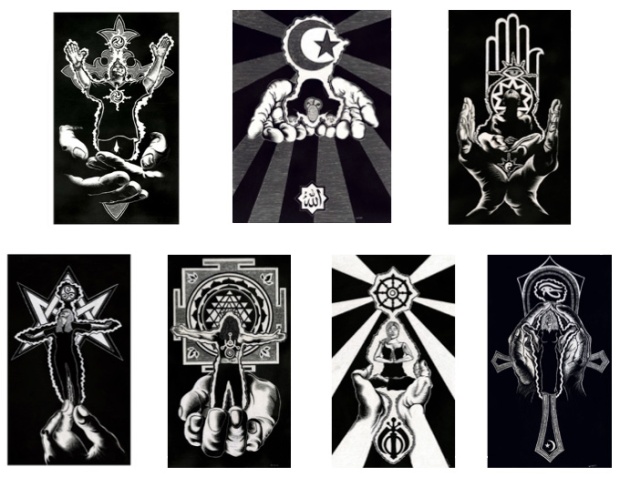
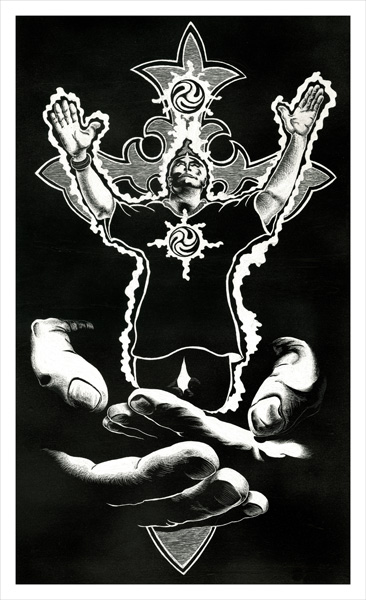
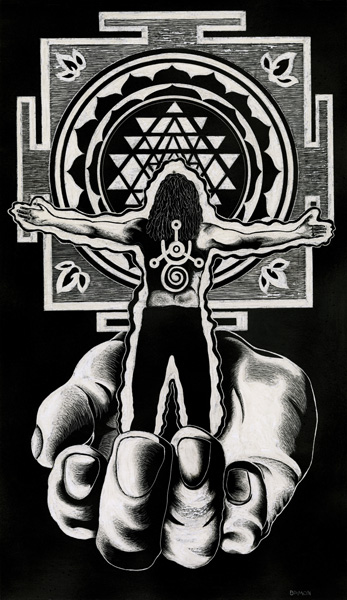

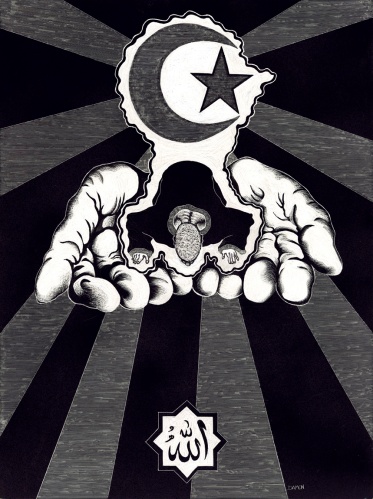
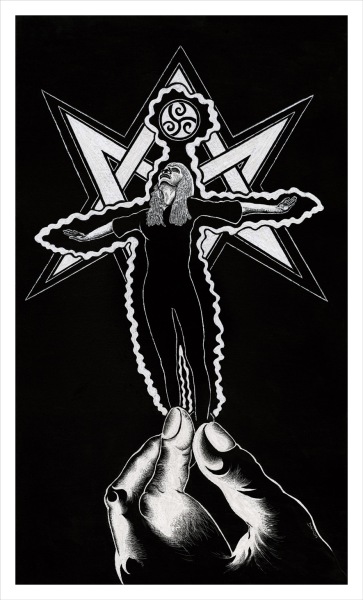
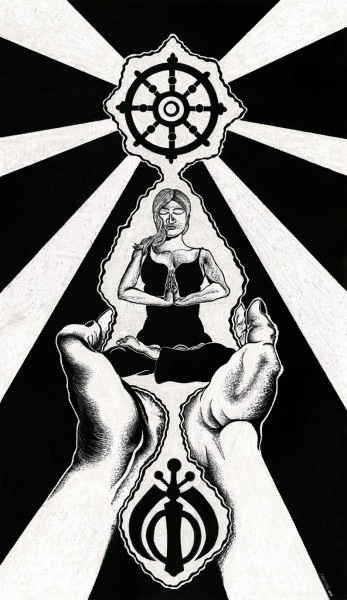


The Eye of Horus embodies the fusion of the physical and spiritual realms. It symbolizes the eye lost by Horus during his battle with Set, the god of chaos.https://thehoruseye.net/
LikeLike
Yes, that is also a part of the eye’s symbolism.
LikeLike